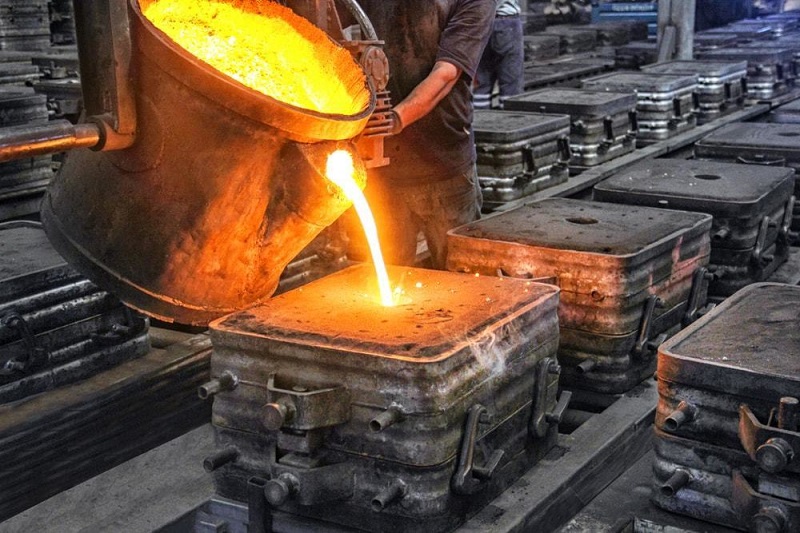China Austenitic Manganese Steel Castings Standard

This standard is used for casting kinds of austenitic manganese steel casting parts.
1.Austenitic Manganese Steel Castings Grades And Chemical Composition
| Grade | Chemical Composition % | ||||||||
| C | Si | Mn | P | S | Cr | Mo | Ni | W | |
| ZG120Mn7Mo1 | 1.05-1.35 | 0.3-0.9 | 6-8 | ≤0.060 | ≤0.040 | – | 0.9-1.2 | – | – |
| ZG110Mn13Mo1 | 0.75-1.35 | 0.3-0.9 | 11-14 | ≤0.060 | ≤0.040 | – | 0.9-1.2 | – | – |
| ZG100Mn13 | 0.90-1.05 | 0.3-0.9 | 11-14 | ≤0.060 | ≤0.040 | – | – | – | – |
| ZG120Mn13 | 1.05-1.35 | 0.3-0.9 | 11-14 | ≤0.060 | ≤0.040 | – | – | – | – |
| ZG120Mn13Cr2 | 1.05-1.35 | 0.3-0.9 | 11-14 | ≤0.060 | ≤0.040 | 1.5-2.5 | – | – | – |
| ZG120Mn13W1 | 1.05-1.35 | 0.3-0.9 | 11-14 | ≤0.060 | ≤0.040 | – | – | – | 0.9-1.2 |
| ZG120Mn13Ni3 | 1.05-1.35 | 0.3-0.9 | 11-14 | ≤0.060 | ≤0.040 | – | – | 3-4 | – |
| ZG90Mn14Mo1 | 0.70-1.00 | 0.3-0.6 | 13-15 | ≤0.070 | ≤0.040 | – | 1.0-1.8 | – | – |
| ZG120Mn17 | 1.05-1.35 | 0.3-0.9 | 16-19 | ≤0.060 | ≤0.040 | – | – | – | – |
| ZG120Mn17Cr2 | 1.05-1.35 | 0.3-0.9 | 16-19 | ≤0.060 | ≤0.040 | 1.5-2.5 | – | – | – |
| Notice: Accept join the element V,Ti,Nb,B,Re | |||||||||
2.Austenitic Manganese Steel Castings Heat Treatment
When casting parts thickness less than 45 mm and carbon content more than 0.8%, ZG90Mn14Mo1 casting parts no need heat treatment; When casting thickness more than 45mm or carbon content more than 0.8%, all grades need water toughening treatment. All casting parts need uniform heating and insulation, water toughening treatment temperature need more than 1040℃, casting parts need put into water-poor quality, and water-poor temperature can not more than 50 ℃
3.Austenitic Manganese Steel Castings Hardness
Except for customer inquiry, the manganese steel casting parts hardness not more than 300 HBW.
4.Austenitic Manganese Steel Castings Surface Quality
- Casting parts are not allowed to have casting defects such as cracks and slag inclusions, sand inclusions, cold insulation, pores, shrinkage holes, shrinkage, and lack of meat that affect the performance.
- Casting parts gates, risers, burrs, and sticky sand should be cleaned. The grinding residues of the gates and risers should meet the requirements of both suppliers and demanders.
- The surface roughness of casting parts should be implemented in accordance with GB / T 6060.1
5.Austenitic Manganese Steel Castings Welding Repair
- Welding repair of casting parts defects is allowed. The defective parts of the casting parts must be cleaned before welding repair. After welding repair, the use and appearance quality of the casting parts should not be affected.
- The depth of the groove prepared for the welding repair surface of the casting exceeds 40% or 25mm of the wall thickness, which is considered as a major welding repair.
- Major welding repairs must be agreed in advance by the buyer. For major welding repairs, there should be a record of the location and extent of the welding repairs.
6.Austenitic Manganese Steel Castings Cleaning
The removal of gates, risers and vents can be accomplished in a few different ways for manganese steel castings. If the castings are allowed to cool to room temperature after shakeout, most of the rigging can be broken or flogged off of the casting. The casting will be fairly brittle at this point and removal of these items with an impact force can be quite effective. Once heat-treated, however, it will no longer be possible to break anything of size off of the casting. Cutting will be required to remove the rigging from the casting once it has been heat-treated. This can be accomplished by abrasive cutting, torch cutting, or arc air gouging. Torch cutting is somewhat difficult and produces high volumes of smoke, due to the high alloy content of manganese steels. It is typical to use torch tip sizes that are much larger than what is needed for carbon steel. Properly designed dust and smoke collection systems are required when using hot methods to cut manganese steels. Care must also be taken not to overheat the manganese steel when doing hot work. Fast cuts and moving around the casting to avoid concentrating the heat are advisable in order to minimize the damaging effect of overheating.
7. Austenitic Manganese Steel Castings Machining
Manganese steel’s unique wear-resistant properties also make it very difficult to machine, at best. In the early days of manganese steel production, it was thought to be unmachineable and grinding was used to shape the parts. Now with modern cutting tools, it is possible to turn, bore and mill manganese steels. Manganese steel does not machine-like other steels and typically requires tools that are made with a negative rake angle. In addition, relatively low surface speeds with large depths of cut produce the best results. This arrangement produces high cutting forces and the equipment and tooling must be robust to withstand these forces. Any chatter of the tooling can add to the work hardening of the surface being machined. Most cutting is typically done without any sort of lubrication. During the machining of manganese, it is important to continuously remove the work-hardened zone with the next cut. Small finishing cuts or tool chatter will cause the hardness to build and make the remaining surface virtually unmachineable.
Drilling of manganese steels, while possible, is very difficult and required holes should be cast into the part versus drilled. If drilled holes are required, mild steel inserts are often cast into the part so that the machineable insert can be drilled or drilled and tapped.
Mr. Nick Sun NICK@XZHUAGANG.COM
Post time: Oct-23-2020
